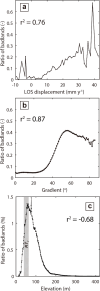Badland distribution as a marker of rapid tectonic activity
- PMID: 40335524
- PMCID: PMC12059066
- DOI: 10.1038/s41598-025-00795-9
Badland distribution as a marker of rapid tectonic activity
Abstract
Tectonically driven processes, such as uplift and horizontal advection of rock mass, are important controls on landscape form and dynamics. Available fluvial topographic indicators are intended to be applied to slowly evolving systems over millennial time scales, which may prevent extracting short-term rapid tectonic effects (~ 1ky). Fast-eroding badlands provide an opportunity to study landscape response to uplift over short time scales. Here, using 1 m airborne LiDAR topographic data in the tectonically active area of southwestern Taiwan, we find that badlands occur within the most rapidly uplifting areas of the landscape, where uplift rates exceed 7 mm y- 1. Furthermore, badlands are predominantly observed within the altitude range that coincides with rapid uplift at 1.3-1.5 kyBP, implying that they formed in response to meso-scale (< 100 km2) rapid incision of tributaries. We demonstrate how the existing landscape-archive framework, connecting dimensionless erosion rate and relief for hillslopes, can be used on highly erodible badland morphology. As such, badlands can provide archives of uplift history for transient landscapes, which allows to target shorter timescales than previously possible.
© 2025. The Author(s).
Conflict of interest statement
Declarations. Competing interests: The authors declare no competing interests.
Figures




References
-
- Parker, R. et al. Mass wasting triggered by the 2008 Wenchuan earthquake is greater than orogenic growth. Nat. Geosci.4, 449–452 (2011).
-
- Willett, S. D. Orogeny and orography: the effects of erosion on the structure of mountain belts. J. Geophys. Res.104, 28957–28981 (1999).
-
- Sean, D. et al. Dynamic reorganization of river basins. Science343, 1248765 (2014). - PubMed
-
- Cattin, R. & Avouac, J. P. Modeling mountain Building and the seismic cycle in the himalaya of Nepal. J. Geophys. Res.105, 13389–13407 (2000).
-
- Howard, A. D. & Kerby, G. Channel changes in Badlands. Geol. Soc. Am. Bull.94, 739–752 (1983).
LinkOut - more resources
Full Text Sources
Research Materials

